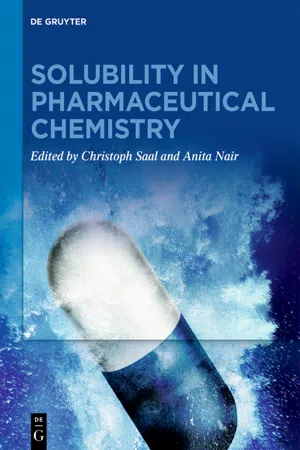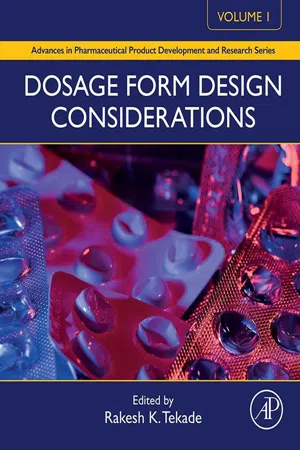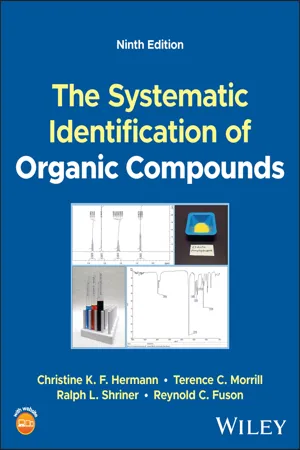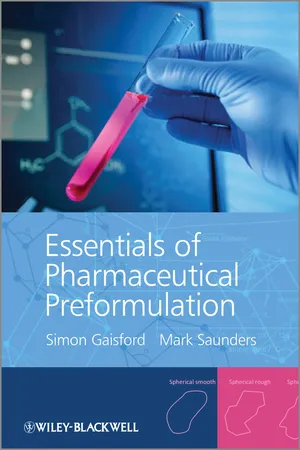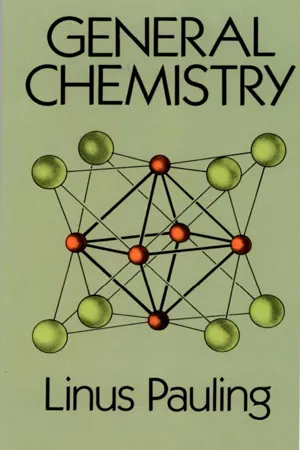Chemistry
Solubility
Solubility refers to the ability of a substance to dissolve in a solvent to form a homogeneous solution. It is typically expressed as the maximum amount of solute that can dissolve in a given amount of solvent at a specific temperature. Solubility is an important concept in chemistry and is influenced by factors such as temperature, pressure, and the nature of the solute and solvent.
Written by Perlego with AI-assistance
Related key terms
Related key terms
1 of 4
Related key terms
1 of 3
9 Key excerpts on "Solubility"
- eBook - ePub
- Britannica Educational Publishing, Erik Gregersen(Authors)
- 2010(Publication Date)
- Britannica Educational Publishing(Publisher)
CHAPTER 5 LIQUID SOLUTIONS AND SOLUBILITYT he ability of liquids to dissolve solids, other liquids, or gases has long been recognized as one of the fundamental phenomena of nature encountered in daily life. The practical importance of solutions and the need to understand their properties have challenged numerous writers since the Ionian philosophers and Aristotle. Many physicists and chemists have devoted themselves to a study of solutions.A solution is a mixture of two or more chemically distinct substances that is said to be homogeneous on the molecular scale—the composition at any one point in the mixture is the same as that at any other point. This is in contrast to a suspension (or slurry), in which small discontinuous particles are surrounded by a continuous fluid. Although the word solution is commonly applied to the liquid state of matter, solutions of solids and gases are also possible. Brass, for example, is a solution of copper and zinc, and air is a solution primarily of oxygen and nitrogen with a few other gases present in relatively small amounts.The ability of one substance to dissolve another depends always on the chemical nature of the substances, frequently on the temperature, and occasionally on the pressure. Water, for example, readily dissolves methyl alcohol but does not dissolve mercury; it barely dissolves benzene at room temperature but does so increasingly as the temperature rises. While the Solubility in water of the gases present in air is extremely small at atmospheric pressure, it becomes appreciable at high pressures where, in many cases, the Solubility of a gas is (approximately) proportional to its pressure. Thus, a diver breathes air (four-fifths nitrogen) at a pressure corresponding to the pressure around him, and, as he goes deeper, more air dissolves in his blood. If he ascends rapidly, the Solubility of the gases decreases so that they leave his blood suddenly, forming bubbles in the blood vessels. This condition (known as the bends) is extremely painful and may cause death; it can be alleviated by breathing, instead of air, a mixture of helium and oxygen because the Solubility of helium in blood is much lower than that of nitrogen. - eBook - ePub
- Christoph Saal, Anita Nair, Christoph Saal, Anita Nair(Authors)
- 2020(Publication Date)
- De Gruyter(Publisher)
Solubility is a term that is very common in everyday use. We consider a compound to be soluble, when it appears to form a clear solution when a solid form is put into a solvent. Solubility depends on several experimental conditions, such as, what is the solvent, what is the temperature, and what is the solid-state form of the material? From a medicinal chemistry perspective, it is very common to be concerned about low Solubility of compounds early in the drug discovery process as it can cause problems in preparing solutions for biological testing. Low Solubility can affect the results of a screening assay as used by the medicinal chemist, which relies on a known concentration of the molecule in solution under the assay conditions. Low Solubility also affects oral absorption when the compound is administered in a solid form. The compound must be in solution form before it can be absorbed through the gastrointestinal tract. It follows that an ideal drug molecule should be soluble enough to be absorbed and circulate in solution in the blood stream and reach the site of action. Additionally, Solubility matters for medicinal chemists for synthesis. In contrast to the other parameters, which have been mentioned, here Solubility in organic solvents is the key. This topic will be addressed in chapter 10 of this book. Pharmacopoeias usually describe the Solubility of a compound by stating how many units of solvent are needed to dissolve a unit weight of a solid compound in a defined solvent. For example, 1 g of caffeine can be dissolved in 60 g of water. The simplest way to measure Solubility is to weigh a certain amount of compound and add known volume of solvents until it forms clear solutions. Some compounds can take longer to dissolve and need more stirring. Therefore, the definition and precise measurement of Solubility are complex. It is even more difficult to define good or bad Solubility because it depends on the purpose and condition for which we need to achieve the desired Solubility.The thermodynamic definition of Solubility is the concentration of the saturated solution of a substance that is in equilibrium with a defined solid-state form of the compound, as discussed more in detail in Chapters 1 and 9. This concentration must be cited together with the solvent. It is also necessary to define the temperature at which the equilibrium between the solid and dissolved form was achieved and when the solvent is water, to state the pH and ionic strength. It is very important to describe the solid-state form of the compound (amorphous or crystalline including polymorph) as the Solubility of different solid-state forms of the same compound may differ by orders of magnitude. To assess when equilibrium has been reached and a saturated solution is obtained, it is necessary to measure the concentration of the compound at various time points, and to check that the solid-state form of the compound has not changed during the measurement.In drug discovery it may be advantageous to approach Solubility from a physiological point of view. The drug molecules must be dissolved in the gastrointestinal tract to be able to be absorbed. The pH ranges from about 2 to 8 during the drug transit through the gastrointestinal tract to reach absorption. Therefore, it is essential to know the Solubility – pH profile. The FDA defines the Solubility as good when the highest dose strength is dissolved in 250 mL of water in a pH range of 1–7.5 [1 ]. This is because it can be expected that the patient will drink a glass of water when taking the drug orally, and there is a wide pH range from the stomach to the small intestine in which the drug should stay in solution and not precipitate. The dissolved drug molecule then needs to be able to cross the intestinal wall that requires it to have suitable permeability and lipophilicity. Therefore, the Solubility together with the partition coefficients of drugs are important factors in influencing the oral absorption and in vivo distribution [2 , 3 ]. The initial rate of dissolution of a drug molecule from the formulation in aqueous media is a direct function of the aqueous Solubility [4 - Stephen R. Byrn, George Zografi, Xiaoming (Sean) Chen(Authors)
- 2017(Publication Date)
- Wiley(Publisher)
17 Solubility AND DISSOLUTION17.1 INTRODUCTION
The Solubility of drugs in various solvents, particularly water, is a critical physical property that affects their stability, bioavailabilty, and therapeutic activity in various drug products. For example, all drugs must dissolve into biological fluids after administration before absorption can occur across biological membranes into the systemic circulation, whereas drugs in solution generally have much greater rates of chemical reactivity and instability than when in the solid form. Additionally, a drug generally must be solubilized before it can be analyzed by various analytical techniques such as HPLC, NMR, and mass spectrometry, and must be in solution during many processes, such as crystallization, and spray drying. In addition, most parental products must be administered as solutions, particularly when using them for administration by the intravenous route. It is well recognized that the Solubility of a drug is primarily determined by such factors as crystal form, amorphous content, pH, temperature, and the presence of surfactants. Of particular importance in the selection of drug candidates is the often need to enhance the Solubility and dissolution of normally poorly soluble drugs to improve oral absorption and bioavailability. In this regard, Solubility data in combination with permeability are utilized to categorize the potential oral bioavailability of new chemical entities and drug candidates by using the Biopharmaceutical Classification System (BCS) [1].While Solubility values are generally taken as the amount of drug in solution in equilibrium with a solid, and therefore a measure of the thermodynamic potential for a drug to dissolve under a given set of conditions, the term drug dissolution is used to describe the rate at which a drug will dissolve under a given set of conditions. Thus, the rate of dissolution is a critical parameter in establishing, for example, the relationship of dissolution to ultimate bioavailability and in vivo performance. In vitro dissolution tests play a crucial role in guiding formulation development and optimization, with dissolution data being a major part of the analytical information required for assuring the quality control of tablets and capsules as commercial products. Dissolution testing, in some cases, can be used as a surrogate tool to predict in vivo- eBook - ePub
- (Author)
- 2018(Publication Date)
- Academic Press(Publisher)
olubility may be defined as the concentration of the solute in concentrated solution at a certain temperature. When it comes to qualitative measurement, Solubility is assumed to be a spontaneous interaction of two or more components to produce a homogenous molecular dispersion in a given solvent.15.1.1.1 Importance of Solubility and Solubilization in Product Development
The efficient delivery of drugs is the issue of prime importance to the makers of pharmaceuticals. Approximately 40% of marketed drugs have low Solubility and almost 80%–90% drug candidates in the R&D product development pipeline fail due to the Solubility concerns. As discussed above, the therapeutic efficacy of a drug depends on the bioavailability, and ultimately upon the Solubility of drug molecules. The Solubility is one of the imperative parameters to accomplish the desired drug concentration in systemic circulation for achieve the required pharmacological.For the effective absorption of a drug, it must be present in the form of an aqueous solution at the site of absorption. Therefore, water is the solvent of choice for liquid pharmaceutical formulations. Most drugs are weakly acidic or weakly basic with poor aqueous Solubility. For this reason, several techniques are used to improve the Solubility of poorly water-soluble drugs.15.1.1.2 Process of Solubilization
The method of dissolving solute involves the breakage of intermolecular or interionic bonds in the solute molecule, the split-up of the solvent component to provide space in the solvent for the solute, and interaction between the solvent and the solute molecule or ion. The change in enthalpy of the solution denotes the total quantity of heat released/absorbed during solubilization.15.1.1.3 Solvent–Solute Interactions
During the product development, choice of the appropriate solvent depends on the principle of “like dissolves like,” which means solute preferentially dissolves in the solvent with alike physicochemical characteristics. In other words, two substances with similar intermolecular forces are soluble in each other. For example, polar solutes like common salt and sugar dissolve in polar solvents like water. Similarly, the nonpolar solutes dissolve in nonpolar solvents, for example, naphthalene solubilized in benzene. - eBook - ePub
Biopharmaceutics
From Fundamentals to Industrial Practice
- Hannah Batchelor, Hannah Batchelor(Authors)
- 2021(Publication Date)
- Wiley(Publisher)
4 SolubilityHannah BatchelorStrathclyde Institute of Pharmacy and Biomedical Sciences, University of Strathclyde, Glasgow, United Kingdom4.1 Definition of Solubility
Solubility is a measurement of the amount of a substance that can stay in a solvent without precipitation. Solubility may be expressed in units of concentration, molality, mole fraction, mole ratio and other units. For the purposes of biopharmaceutics, the substance of interest is usually the API and the solvent will vary depending upon the physiological region of interest; for example the stomach, small intestine or pulmonary fluid.A drug's structure determines its Solubility as the chemical structure will also determine lipophilicity, hydrogen bonding, molecular volume, crystal energy and ionisability. Thus during lead compound optimisation, there is scope to balance potency with Solubility [1] .The Solubility of a substance can change when pressure, temperature and/or the composition of the solvent changes thus it is important to accurately detail Solubility data to provide sufficient information.4.2 The Importance of Solubility in Biopharmaceutics
Poor aqueous Solubility of a drug can lead to issues during the preclinical phase of drug development and beyond. Insufficient Solubility within the gastrointestinal lumen can limit absorption and subsequent exposure to the drug in question. Thus, the Solubility of a drug candidate will impact upon decisions and risk assessments undertaken during development.There has been an increase in the proportion of poorly water‐soluble drugs with estimates of up to 75% of candidates in development being classified as low aqueous Solubility [2] . This trend towards increasing proportions of low aqueous Solubility drugs is linked to the drive towards potent and selective drugs where candidate optimisation often adds lipophilic groups to enhance binding, yet the lipophilicity of the resulting molecule increases. However, poorly water‐soluble candidate drugs are associated with higher rates of attrition as well as higher costs during drug development [3] . Furthermore, poorly water‐soluble drugs are associated with greater inter‐individual pharmacokinetic variability as well as being susceptible to food effects [3] - eBook - ePub
Environmental Engineering
Principles and Practice
- Richard O. Mines(Author)
- 2014(Publication Date)
- Wiley-Blackwell(Publisher)
2.7 Solubility (Solubility product) So far, we have dealt with aqueous solutions in which the chemical species are highly soluble. In this section, our focus will be on liquid-solid species that are partially soluble or insoluble. All solids, no matter how seemingly insoluble, are soluble to some degree. When a solid is placed in water, the ions at the surface of the solid will migrate into the water. This is called dissolution. Simultaneously, ions in the solution will be redeposited on the surface of the solid; this is known as precipitation. Equilibrium will be reached between the crystals of the compound in the solid state and its ions in solution. In general, the Solubility of most compounds increases with increasing temperature. Snoeyink & Jenkins (1980, page 251) indicate that the solubilities of and do not increase as temperature increases. Equation (2.112) shows the general equation of a solid compound dissolving in pure water to form its constituent ions. 2.112 The equilibrium expression is written as follows: 2.113 As described by Sawyer & McCarty (1994, page 37), at equilibrium or saturation, the surface area of the solid is the only portion that is in equilibrium with the ions in solution. Therefore, the concentration of solid as represented by in the denominator of Equation (2.113) can be considered a constant in equilibrium Solubility problems. Equation (2.114) is rewritten to show the development of the Solubility-product constant, 2.114 2.115 When the solution is saturated or at equilibrium. When the solution is under-saturated and no solids species are present. When the solution is super-saturated and solid species are being formed. The Solubility-product constants for several solids of significance in environmental engineering are presented in Table 2.16. Partially soluble salts have small values, while soluble salts have relatively large values - Christine K. F. Hermann, Terence C. Morrill, Ralph L. Shriner, Reynold C. Fuson(Authors)
- 2023(Publication Date)
- Wiley(Publisher)
Chapter 5 Classification of Organic Compounds by SolubilityIn this chapter, we begin the process of determining the structural composition of organic compounds. The elemental composition obtained in Chapter 4 can be of use here. Both Solubility and spectrometric analyses (Chapters 7 –9 ) often lead to the same kinds of structural deduction. Deductions based on the interpretation of simple Solubility tests can be extremely useful in organic structure determination.Before proceeding, the difference between Solubility and a chemical reaction must be ascertained. In some cases, a chemical reaction is accompanied by a change in color or heat or by the formation of a precipitate. Solubility involves the formation of one layer if the compounds are miscible, or two layers, if the compounds are immiscible.The Solubility of organic compounds can be divided into two major categories: Solubility in which a chemical reaction is a driving force, for example, the following acid‐base reaction, and Solubility in which simple miscibility is the only mechanism involved, such as dissolving ethyl ether in carbon tetrachloride. An example of an acid‐base reaction is given below:Although the two Solubility sections below are interrelated, the first section deals primarily with the identification of functional groups and the second with the determination of solvents to be used in recrystallizations, spectral analyses, and chemical reactions.5.1 Solubility IN WATER, AQUEOUS ACIDS AND BASES, AND ETHER
Three kinds of information can often be obtained about an unknown substance by a study of its solubilities in water, 5% sodium hydroxide solution, 5% sodium bicarbonate solution, 5% hydrochloric acid solution, and cold concentrated sulfuric acid. First, the presence of a functional group is often indicated. For instance, because hydrocarbons are insoluble in water, the mere fact that an unknown is partially soluble in water indicates that a polar functional group is present. Second, Solubility in certain solvents often leads to more specific information about the functional group. For example, benzoic acid is insoluble in a polar solvent, water, but is converted by 5% sodium hydroxide solution to a salt, sodium benzoate, which is readily water soluble. In this case, then, the Solubility in 5% sodium hydroxide solution of a water‐insoluble unknown is a strong indication of an acidic functional group. Finally, certain deductions about molecular size and composition may sometimes be made. For example, in many homologous series of monofunctional compounds, the members with fewer than about five carbon atoms are water soluble, whereas the higher homologs are insoluble.- eBook - ePub
- Simon Gaisford, Mark Saunders(Authors)
- 2012(Publication Date)
- Wiley-Blackwell(Publisher)
4.5 ) the reason for the term equilibrium Solubility noted earlier.It appears from Equation (4.2 ) that the crystal lattice energy might affect Solubility. It also seems from Equation (4.1 ) that there should be an effect of temperature on Solubility, since the position of equilibrium will change. Both of these effects can be explored further through the concept of ideal Solubility .Summary box 4.14.2.1 Ideal Solubility- Solubility is the maximum concentration of a given solute that can be attained in a given solvent.
- Solids transition to solution by dissolution.
- Thermodynamic Solubility is a position of equilibrium.
- Dissolution governs the rate at which Solubility is achieved.
- As a general rule, Solubility below 1 mg mL−1 is likely to hinder development while Solubility above 10 mg mL−1 is acceptable.
In the special case where the enthalpy of any solute–solvent interaction is equal to the enthalpy of any solvent–solvent interaction then solvation of the solute may occur with no change in enthalpy (i.e. Δmix H = 0) and dissolution is said to be ideal . Formation of an ideal solution also occurs with the following change in entropy ( ):(4.6)where R is the universal gas constant (8.314 J K−1 mol−1 ). Ideal dissolution (although unlikely, because the solute and solvent molecules would need to possess identical properties, such as size, shape and chemical nature) leads to ideal Solubility and is an interesting theoretical position because it can be described in thermodynamic terms, which allows calculation of the dependence of Solubility on temperature.From Equation (4.2 ) if Δmix H = 0 then Δf H is equal to Δsol H (note that since Δf H must be positive, i.e. endothermic, Δsol H must also be positive for ideal dissolution). For a process to occur spontaneously the Gibbs free energy (ΔG ) must be negative. The familiar thermodynamic relationship for dissolution is(4.7)where T is absolute temperature. Δsol G is most likely to be negative when Δsol H is negative but, as noted above, Δsol H is frequently positive for dissolution and must be so when dissolution is ideal. This means that for dissolution to occur spontaneously the driving force can only be a significant increase in entropy. Since the mole fractions of both solvent and solute must be less than 1, the logarithmic terms in Equation (4.6 - eBook - ePub
- Linus Pauling(Author)
- 2014(Publication Date)
- Dover Publications(Publisher)
For example, the enthalpy of solution of Na 2 SO 4 ×10H 2 O in water is 79 kJ per gram formula weight. The formal enthalpy of solution of sodium chloride is 5.4 kJ and that of Na 2 SO 4 is −23 kJ. 13-3. The Dependence of Solubility on the Nature of Solute and Solvent Substances vary greatly in their solubilities in various solvents. There are a few general rules about Solubility, which, however, apply in the main to organic compounds. One of these rules is that a substance tends to dissolve in solvents that are chemically similar to it. For example, the hydrocarbon naphthalene, C 10 H 8, has a high Solubility in gasoline, which is a mixture of hydrocarbons; it has a somewhat smaller Solubility in ethyl alcohol, C 2 H 5 OH, whose molecules consist of short hydrocarbon chains with hydroxide groups attached, and a very small Solubility in water, which is much different from a hydrocarbon. On the other hand, boric acid, B(OH) 3, a hydroxide compound, is moderately soluble in both water and alcohol, which themselves contain hydroxide groups, and is insoluble in gasoline. In fact, the three solvents themselves show the same phenomenon—both gasoline and water are soluble in alcohol, whereas gasoline and water dissolve in each other only in very small amounts. The explanation of these facts is the following. Hydrocarbon groups (involving only carbon and hydrogen atoms) attract hydrocarbon groups only weakly, as is shown by the low melting and boiling points of hydrocarbons, relative to other substances with similar molecular weights. But hydroxide groups and water molecules show very strong intermolecular attraction; the melting point and boiling point of water are higher than those of any other substance with low molecular weight. This strong attraction is due to the partial ionic character of the O—H bonds, which places electric charges on the atoms
Index pages curate the most relevant extracts from our library of academic textbooks. They’ve been created using an in-house natural language model (NLM), each adding context and meaning to key research topics.
Explore more topic indexes
Explore more topic indexes
1 of 6
Explore more topic indexes
1 of 4

